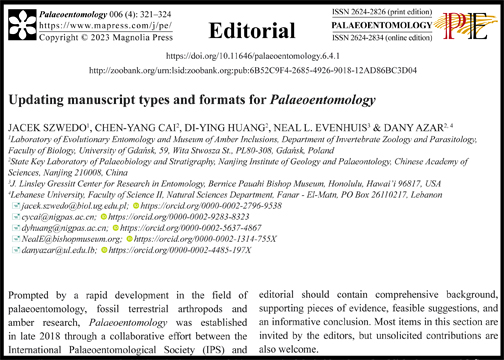Abstract
Prompted by a rapid development in the field of palaeoentomology, fossil terrestrial arthropods and amber research, Palaeoentomology was established in late 2018 through a collaborative effort between the International Palaeoentomological Society (IPS) and Magnolia Press (Azar et al., 2018). The inception of this scientific journal was met with enthusiastic reception from the palaeoentomological and amber community, and it achieved a consistent and robust growth throughout its initial five-year period (2018–2022). A significant milestone was attained in November 2022, as Palaeoentomology was granted acceptance into the Emerging Sources Citation Index™ (ESCI) within the esteemed Web of Science Core Collection™, a recognition indicative of its emerging influence. All papers published between 2018 and 2022 within Palaeoentomology were incorporated into the ESCI in January 2023, solidifying the journal’s presence and visibility within the scholarly landscape. More recently, according to June 2023 release of Journal Citation Reports, the 2022 journal impact factor of Palaeoentomology is 2.3, which is slightly higher than 2.2 estimated by Zhang (2023). Boasting a substantial impact factor, Palaeoentomology secures an impressive 20th position among 108 peers in the field of PALEONTOLOGY (Q1) and 8th position out of 57 in ENTOMOLOGY (Q1), further accentuating its influential stature (Clarivate Analytics, 2023). In order to continue fostering the rapid advancement of the journal, we are now implementing updates to the manuscript format of new submissions. A brief description of each article type is provided below.
References
- Azar, D., Szwedo, J., Jarzembowski, E., Evenhuis, N. & Huang, D.Y. (2018) “Palaeoentomology”: A modern journal for a science dealing with the past. Palaeoentomology, 1 (1), 1–2. https://doi.org/10.11646/palaeoentomology.1.1.1
- Bengtson, P. (1988) Open nomenclature. Palaeontology, 31 (1), 223–227.
- Cifelli, R.L. & Kielan-Jaworowska, Z. (2005) Diagnosis: Differing interpretations of the ICZN. Acta Palaeontologica Polonica, 50 (3), 650–652.
- Clarivate Analytics (2023) Palaeoentomology (IF, 2.3) ranking in PALEONTOLOGY (20/108, Q1) and ENTOMOLOGY (8/57, Q1) based on Web of Science. Available from https://apps.webofknowledge.com (accessed 14 August 2023).
- ICZN [International Commission on Zoological Nomenclature] (1999) International Code of Zoological Nomenclature. 4th edition [incorporating A. Declaration 45, Addition of Recommendations to Article 73 and of the term “specimen, preserved” to the Glossary, B. Declaration 44, amendments of Article 74.7.3, with effect from 31 December 1999, and C. the Amendment on e-publication, amendments to Articles 8, 9, 10, 21 and 78, with effect from 1 January 2012]. (Available online at: https://www.iczn.org/the-code/the-code-online/ )
- May, T.W., Redhead, S.A., Bensch, K, Hawksworth, D.L., Lendemer, J., Lobard, L. & Turland, N.J (2019) Chapter F of the International Code of Nomenclature for algae, fungi, and plants as approved by the 11th International Mycological Congress, San Juan, Puerto Rico, July 2018. IMA Fungus, 10 (21), 1–14. https://doi.org/10.1186/s43008-019-0019-1
- Turland, N.J., Wiersema, J.H., Barrie, F.R., Greuter, W., Hawksworth, D.L., Herendeen, P.S., Knapp, S., Kusber, W.H., Li, D.Z., Marhold, K., May, T.W., McNeill, J., Monro, A.M., Prado, J., Price, M.J. & Smith, G.F. (Eds) (2018) International Code of Nomenclature for algae, fungi, and plants (Shenzhen Code) adopted by the Nineteenth International Botanical Congress Shenzhen, China, July 2017. Regnum Vegetabile 159. Koeltz Botanical Books, Glashütten. (Available at: https://www.iapt-taxon.org/nomen/main.php )
- Zhang, Z.Q. (2023) Palaeoentomology (2018–2022): A newcomer on the rise to high impact. Palaeoentomology, 6 (3), 215–218. https://doi.org/10.11646/palaeoentomology.6.3.1


